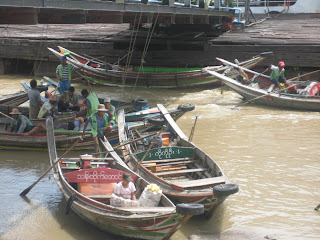
The last in our Burma travel series, Jeff Duncan, Jaunt Contributor and GM of Stage Three Music, takes us to Bagan, the final stop on his journey throughout the beautiful grit that is Burma.
Part 3: Bagan, Original Majesty
"You’re scared aren’t you?" Said my friend.

We were up far enough up on the pagoda that a fall down the deceptively steep, sharp brick steps would be ugly. I wondered how many unlucky schlubs had taken that tumble over the last thousand years. It would be the type of fall that can’t be stopped. The victim would only gain speed and torque as they log-rolled to the bottom, each thud against the bricks doing real damage.
Was there even a hospital within 100 miles?
"Stop projecting. And, yes." I replied.

Ungracefully (and not very heroically), we crawled, hunched over like crabs to summit the ancient edifice. When we arrived at the top, I looked out over the lush green landscape, punctuated by hundreds of clay-red stupas. It was still and a slight mist of rain cooled my face as the sun set slowly.
It was likely my emotions, but I sensed an energy, a deep & phasing, barely sub-aural cycling of power. I kept my mouth shut about it. It was the perfection I’d not even been aware I was searching for; simultaneous stillness, solitude, antiquity and natural splendor. It was fleeting.
Behind us, an agile old local had followed us up. He began his mantra of "You buy! You buy!" holding up his indigenous paintings. I gently indicated that I would have a look if he met us in 10 minutes down by our minivan (with the broken AC - every car we took in Burma had broken AC, at least that’s what we were told). He persisted, but I pointed at the view and gave him the 1 minute signal. The local vendors had extra vigor, presumably because the tourists were staying away due to the recent protests and unrest. Still, I felt a bit bastardly moving him along. The feeling later eased when I bought two of his paintings.

The two-punch combo of a depressed economy and repressive government is a wicked one, so far as I can tell, but the people live on and seem connected to their fascinating history.
We needed some local cash. Our US $20's were slightly more fire power than necessary so we took a ride to our driver’s Aunt’s house; she had a black market side-gig changing currency. Very Burma. On the way, we passed the ridiculous golf course the military had built in the middle of the stunning plain…“Let’s shoot 18 in the ruins Bro….Sweet!” I think the regime is far more suited to run a dog circus than a country.
The Aunt’s dwelling was a dark-wood and straw mat affair slightly off the main drag. Lit only by candles (the whole town had lost power for no particular reason, which is common), it felt slightly spooky-warm and seemed an extension of the clay earth it was built upon. I caught myself scanning the dark corners of the room for some thieving marauder ready to jump us for our money belts, but quickly shrugged off my American paranoia when his thin old Aunt appeared with her happy eyes and missing-tooth smile.

The Burmese will only accept crisp fresh dollars; any tear, crumple, fold or stain and it’s rendered useless to them. I’ve heard tales of tourists damn near starving to death with a wallet full of worthless, fouled money who are then forced to go to their embassy for a hand out. Fortunately, mine wasn’t so dirty and the old lady, with surprising skill and speed, counted out a fat stack of the equivalent kyat, less her commission, of course. Kyat makes a man with forty bucks feel rich; the size of the currency and exchange rate the way it is leaves one with an obscene wad of the stuff that’s better stowed in a chamber pot than a billfold.
After dinner I was beat, and on the way back to the cabanas our driver noticed me rubbing my sore neck.
"Can I recommend a traditional Burmese massage?" He offered in his unexpectedly polished English.
Now there is an idea, and a fine one at that. A perfect end to a perfect day.
"Where do we go?" I anxiously queried.
"Oh, they come to your hotel," he said. I envisioned a slow, two-hour deep oil rub from some skilled, local beauty. She’d relax every muscle and smooth each sinew and I’d drift away deep and heavy to awake anew tomorrow.
"To send the man over it will cost $10 US dollars for each of you," he added.

My prior vision was abruptly smashed, replaced by one that involved my lower back being tickled by some dangling beard…piss.
"Can’t you send women over?" I asked, before really thinking it through.
"Sir, I will tell you that this is a historic site and we don’t...." he rattled.
"Hey, wait... I’m sorry... I didn’t mean... I just want a massage, I think you misunderstand. I don’t like to get rubbed by men..." I foolishly stammered.
He was peeved.
After copious explanations and back trackings, the guy seemed mildly assured we weren’t another gaggle of American sex tourists who took a wrong turn at Bangkok.
As I waited for sleep with a stiff neck, I left the window open and listened to the thunderstorms rolling across the plain of Bagan and wished we’d had one more day there.
By Jeff Duncan





























